
About UsThe Numismatic Bibliomania Society is a non-profit organization promoting numismatic literature. For more information please see our web site at coinbooks.org SubscriptionsThose wishing to become new E-Sylum subscribers (or wishing to Unsubscribe) can go to the following web page link MembershipThere is a membership application available on the web site Membership Application To join, print the application and return it with your check to the address printed on the application. Membership is only $15 to addresses in the U.S., $20 for First Class mail, and $25 elsewhere. For those without web access, write to: David M. Sundman, Treasurer AsylumFor Asylum mailing address changes and other membership questions, contact David at this email address: dsundman@LittletonCoin.com SubmissionsTo submit items for publication in The E-Sylum, just Reply to this message, or write to the Editor at this address: whomren@gmail.com
BUY THE BOOK BEFORE THE COIN |
- WAYNE'S WORDS: THE E-SYLUM SEPTEMBER 8, 2013
- SKLOW LITERATURE SALE 20 CLOSES OCTOBER 12, 2013
- NEW BOOK: ULTRA MODERN DOUBLED DIES 1996 – 2012
- BOOK REVIEW: COMMUNION TOKENS
- BOOK REVIEW: KASHMIR COINS
- BOOK REVIEW: THE WISHFUL PENNY
- O NVMISMATA (THE NVMISMATIST) NO. 2 PUBLISHED
- ERIC VON KLINGER, 1946 - 2013
- ANS SYMPOSIUM ON EARLY ELECTRUM COINAGE NOVEMBER 2013
- AN AUTHOR'S EXPERIENCE: CREATESPACE AND AMAZON.COM
- KARL MOULTON ON THE "GREAT DEBATE" TAPES
- THIAN'S REGISTER OF THE CONFEDERATE DEBT
- MORE ON EXCHANGING DEMONETIZED MONEY
- ALUMINUM WRONG PLANCHET ERRORS
- MORE ON SILVER PLUGS IN SILVER COINS
- WERE WALTON'S COINS REALLY SCATTERED ON THE HIGHWAY?
- HARVEY STACK ON THE JOHN J. FORD COLLECTION SALES
- MORE ON JOHN MAYNARD KEYNES AND YAP STONE MONEY
- ARTICLE EXPLORES: ARE BANKNOTES SEXIST?
- MORE ON THE LEGAL TENDER STATUS OF U.S. COINS
- ARTICLE INTERVIEWS PHILADELPHIA MINT ARTISTS
- QUERY: 'NUMISMATIC TIMES AND TRENDS' INFORMATION SOUGHT
- QUERY: ARE THERE ANY SEARCH SITES FOR OLD MAGAZINES?
- A LABOR DAY GOLD COIN AND JEWELRY FIND
- ROYAL MINT ISSUES BENJAMIN BRITTEN 50 PENCE COIN
- COIN FIND OF THE CENTURY DONATED TO ROMANIAN MUSEUM
- LOTS FROM THE KOLBE-FANNING SALE #130: CONDER, VAN LOON
- FOURTH EXAMPLE OF ANTONY AND CLEOPATRA "LOVERS' COIN" FOUND
- WERTPAPIERWELT: THE MUSEUM OF HISTORICAL SHARES AND BONDS
- COOK ISLANDS COIN CONTAINS PIECE OF CHELYABINSK METEORITE
- BALDWIN'S 83RD SALE TO BE HELD SEPTEMBER 24, 2013
- FEATURED WEB PAGE: NOVA EBORAC COPPERS
Click here to access the complete archive
To comment or submit articles, reply to whomren@gmail.com
WAYNE'S WORDS: THE E-SYLUM SEPTEMBER 8, 2013

New subscribers this week include Kris Briggs of Stacks Bowers Galleries, Daniele Del Bo, and Jacob Lipson. Welcome aboard! We have 1,679 email subscribers, plus 245 followers on Facebook.
This week we open with an update from David Sklow about his October numismatic literature sale, one new book and three reviews. Other topics include Thian's Register of the Confederate Debt, modern coin-making at the Philadelphia Mint, wrong planchet errors, electrum coinage, and the Museum of Historical Shares and Bonds.
To learn more about Communion Tokens, Ephraim Brasher and the Brazilian gold, sculpting coins in Adobe Photoshop, the Lovers' Coin, and drunkards, fornicators and witches (oh, my!), read on. Have a great week, everyone!
Wayne Homren
Editor, The E-Sylum
SKLOW LITERATURE SALE 20 CLOSES OCTOBER 12, 2013
MAIL BID SALE NO. 20 CLOSES OCTOBER 12, 2013
OUR 30TH ANNIVERSARY AUCTION AND OUR LARGEST CATALOG TO DATE!
FEATURED ITEMS INCLUDE:
-
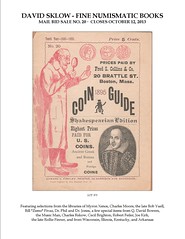 Run of ANA Badges & Medals
Run of ANA Badges & Medals
- Items from the library of the late Rollie Finner
- Items from the library of the late Bob Yuell
- Complete offering of the works of John S. Davenport
- Long run of Haseltine catalogs
- Several runs of the "Redbook"
- David Proskey's annotated Lyman Low catalogue of Hard Times Tokens 1886
- Early deluxe auction catalogs of George F. Kolbe
- Dr. French large cents by B. Max Mehl
- American Numismatic Biographies by Pete Smith
- Complete set of The Money Tree catalogs
- Four photographic albums of the Armand Champa Library auction sales
- Deluxe Stack's auction catalogs
- Runs of Bolender auction catalogs
- Runs of Bluestone auction catalogs
- ANA 1919 auction catalog
- Long run of The Numismatist 1894-1939 both bound & unbound
- Australian History as seen through Banknotes by Dauer
- Long run of The Coin Collector Journal by Raymond
- Numerous 19th century auction catalogs
- Deluxe Obsolete Paper Money of Virginia by Affleck
- Heath's Infallible Counterfeit Detector 1864 pocket edition [Newman # 1-p-20]
- Run of Elder's Monthly, Elder's Magazine, The Numismatic Philistine
- San Francisco Clearing House Certificates by Plehn
- J.S.G. Boggs Smart Money-Hard Currency by The Tampa Museum of Art
- Deluxe Interleaved Maine Obsolete Paper & Scrip by Wait
- A Treatise on Counterfeit, Altered and Spurious Bank Notes, 1865, by Wilber and Eastman
- Super Deluxe Virgil Brand Collection presentation edition
- Presentation deluxe leather bound Roger H. Durand Santa Claus Notes, Q. David Bower's copy
- Silver Dollars & Trade Dollars two volume set by Q. David Bowers
- Run of Empire Topics, Bowers Review, Empire Investors Report
- Coinage of the Confederacy by Borckardt, Ex: Ken Lowe
- The Minting Process by Breen, Ex: Ken Lowe, with purchase invoice
- Description Historique Des Monnaies Frappees Sous L'Empire Romain Communement Appelees Medailles Imperiales, seven volumes by Cohen, Ex: William Sumner Appleton
- Deluxe Money Tells the Story, by Dodson
- Deluxe limited numbered Patriotic Civil War Tokens, by Fuld
- Deluxe limited numbered edition The Engravers Line [with extra bound in engravings] by Hessler
- Chile's Coquimbo Mint, limited numbered edition [#4 of 50] by Jara
- Numismatic Literary Guild Life Member Brass Card of James F. Ruddy
- The United States Mint at Philadelphia, 1903, by James Rankin Young
- History of the First Mint, 1924, by Frank Stewart
- Limited numbered reprint of the Constitution of Western Pennsylvania Numismatic Society, inscribed to Ken Lowe
- Coins of Vermont, by Carlotto
- Deluxe limited numbered The Ultimate Guide to U.S. Three Cent Nickels, by Gifford
- United States Dimes from 1796, reprint by Kosoff, inscribed to Mike Kolman by Abe Kosoff with accompanying letter
- Long run of hard bound standard reference works on United States Coinage by denomination
- Deluxe Hawaiian Money, by Medcalf, inscribed to Myron Xenos
- J.S.G. Boggs, One Dollar F.U.N. note
- And much more!
Bidders may enter bids by mail, telephone, email or fax. The sale closes at 8pm mountain time, October 12, 2013, however, any bids left on our answering machines or sent by email or fax on or before midnight on closing day will be accepted.
Catalogs are available upon request at no charge, and have been mailed to all individuals on our mailing list. The catalog is also viewable on our website
DAVID SKLOW – FINE NUMISMATIC BOOKS
P.O. BOX 6321
COLORADO SPRINGS, CO 80934
TEL: (719) 302-5686
FAX: (719) 302-4933
numismaticbooks@aol.com
www.finenumismaticbooks.com
NEW BOOK: ULTRA MODERN DOUBLED DIES 1996 – 2012
 Dr. James Wiles, Ph.D. has recently released his newest E–Book, Ultra Modern Doubled Dies 1996 – 2012 based on the files and numbering system of CONECA (Combined Organizations of Numismatic Error Collectors of America).
Dr. James Wiles, Ph.D. has recently released his newest E–Book, Ultra Modern Doubled Dies 1996 – 2012 based on the files and numbering system of CONECA (Combined Organizations of Numismatic Error Collectors of America).
Dr. Wiles has been researching, cataloging, and attributing twentieth and now twenty-first century U.S. coins for CONECA since the mid 1990s and he has also written several printed books on many of the different denominations of modern U.S. coinage over this time period. For the past few years, Dr. Wiles has focused on publishing E–Books because they are environmentally friendly and they keep the purchase price of the E–Book affordable. Another added benefit of using this modern technology is that more digital photographs can be included showing the different stages and markers of the die varieties.
Dr. Wiles has now taken his E-Books to the next level by posting updates of the varieties and photographs on his website, http://www.varietyvista.com. When Dr. Wiles attributes and lists a new variety, reports a new stage of a previously listed variety, or gets a chance to post a better photo of the variety, he does so on the website.
If you have previously purchased one of Dr. Wiles’ E-Books or are thinking about purchasing your first, you don't have to wait any longer to find out what has changed. Variety Vista’s website (linked above) is periodically updated as new photographs are taken for the following E-Books:
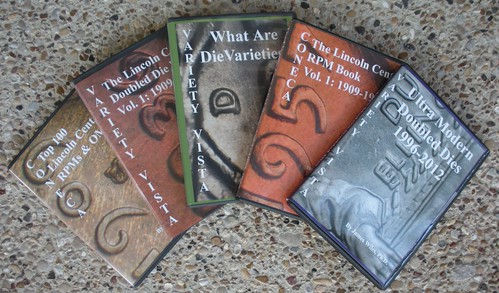
1. Top 100 Lincoln Cent RPMs & OMMs published in 2007.
2. The Lincoln Cent RPM Book, Volume 1 (1909 – 1958) published in 2010.
3. What Are Die Varieties? published in 2011.
4. The Lincoln Cent Doubled Die Book, Volume 1 (1909 – 1958) published in 2011.
5. Ultra Modern Doubled Dies: The Single Squeeze Era (1996 – 2012) published in 2013.
On varietyvista.com, you have access to the most updated information available, so visit the website today, purchase your new books, and enjoy the hobby. All E-Books are $30 each except the Top 100 Lincoln Cent RPMs & OMMs is only $20. Shipping and handling is $4.00 per package and up to 3 E-Books can fit into a single package. Send your check or money order to:
James Wiles
1490 Trail View Lane
Frisco, TX 75034
OR
Using PayPal, send payment to: jameswiles@sbcglobal.net
The Combined Organizations of Numismatic Error Collectors of America (CONECA pronounced: CÔ´NECA) is an international organization devoted to the education of error and variety coin collectors. CONECA focuses on all numismatic errors and varieties including doubled dies, re-punched mintmarks, multiple errors, clips, double strikes, off-metals and off-centers -- just to name a few. CONECA publishes an educational journal, Errorscope, which is printed and mailed to members bimonthly. The digital version of Errorscope is also available in the “Members-Only-Area” going back nearly ten years. CONECA offers a lending library, examination and attribution services. Members receive discounts on examination and attribution fees.
Persons wanting to join CONECA should contact Rachel Irish by email at MRirish5@roadrunner.com or 3807 Belmont Road, Coeur d’Alene, ID 83815.
To access VarietyVista, see: www.varietyvista.com
BOOK REVIEW: COMMUNION TOKENS
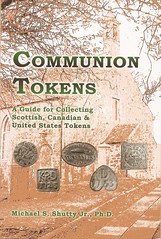 Communion Tokens: A Guide for Collecting Scottish, Canadian & United States Tokens.
Communion Tokens: A Guide for Collecting Scottish, Canadian & United States Tokens.
Author: Michael S. Shutty, Jr.
ISBN-13: 978-1-60047-878-9
Format: 6 x 9 Trade Paperback
Pages: 137
Price: $14.95
I've always liked communion tokens, and was glad to see Mike Shutty's book come along. It's a great introduction to this series. For some background on the tokens, here's a short excerpt:
The use of church tokens to denote worthiness is not unexpected. The press to separate the devout from the profane has always been of paramount concern. In fact, the word token is derived from the Saxon “tacen” or Gothic “taikns” and refers to a sign or mark of distinction. Consequently, the strict bestowal of tokens represented a convenient and reliable way to recognize the faithful. Church tokens used in this way provided some measure of insurance against infiltration by devious outsiders intent on deception, or worse, religious persecution.
It is at this point that the communion tokens, which are the subject of this book, come into play. In fact, they were uniquely suited to the purposes of the early reformation church. John Calvin, one of the chief architects of this movement, is credited with suggesting that tokens be used to determine who in the congregation was worthy of the sacrament of communion. (p10-11)
The communion ceremony is described. Here's a passage relating specifically to the collection of the tokens:
It was a solemn affair, standing in line, gaining entrance one by one, as the elders inspected each token, and dropped it into the bag with a dull click. A second elder consulted the communion rolls to assure that no one could sneak by with a counterfeit. Yet, some folks did try to sneak by. Church records have revealed instances where an outdated token or a worn halfpenny was passed to gain entrance. These folks were strongly reproved when discovered. In addition, some parishioners with valid tokens were refused at the last moment when recognized by another member of the congregation as being a drunkard, a fornicator, or a witch. (p19)
Like many authors, Shutty ended up writing the book he'd always wanted to read. While there are many other books on the topic, most are fairly specialized catalogs with long lists of tokens but little information for a beginner. His book fills that gap admirably.
The first chapter ("Bits of Lead and Tin") discusses his first encounter with a communion token and subsequent search for more information about them. The chapter includes a brief overview of the primary literature on the subject.
The next two chapters ("A Tradition Develops" and "Fencing the Table") describe the historical background and the actual ceremony of Communion. Chapter Four ("Molding and Striking") describes the primary methods of manufacture. Chapters Five and Six cover the churches and the towns they were part of.
All eighteen chapters of the book are short and easy to read, with none being more than about 10 pages long. Chapter Seven is a closer look at the fields of collecting communion tokens, which includes another look at the primary literature and different organizing schemes (such as collecting communion tokens by date, place, style or shape).
Each chapter from Eight through Fifteen covers one of these organizing schemes, including shape ("Squares", "Rounds", "Rectangles", "Ovals", "Odd Shapes"), place ("Canada", "United States"), and "Table Numbers". I wasn't aware of the last type of communion token, used for large ceremonies where table numbers are hand punched into the tokens.
Rounding out the book are chapters on "The Token Marketplace" and "Caring for Tokens". This 137-page book is an excellent introduction to communion tokens of the world. While being a book meant for beginning collectors of the series, it covers the material thoroughly. With a three-page list of References, it passes my back-of-the-book test for numismatic scholarship.
In summary, Communion Tokens is good reading for anyone who's ever sat in a pew, and I would include synagogues, too: the early history of the Christian Church is one of persecution, and communion tokens were born of that stress. These little tokens are badges of both membership and worthiness, with something in common even with the challenge coins of today. I'm going to pass this along to my father-in-law; it's a book appropriate for lay readers as well as seasoned numismatists. I recommend it to E-Sylum readers.
Communion Tokens: A Guide to Collecting Scottish, Canadian & United States Tokens is available on the Wasteland Press website: Books123.org. For more information about the book or the tokens, check out the blog at communiontokens.blogspot.com .
To read the earlier E-Sylum article, see: NEW BOOK: COMMUNION TOKENS (www.coinbooks.org/esylum_v16n29a03.html)
BOOK REVIEW: KASHMIR COINS
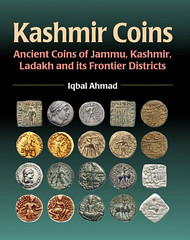 Title: Ancient coins of Jammu, Kashmir, Ladakh and its frontier Districts
Author: Iqbal Ahmad
Publisher: Dilpreet Publishers, New Delhi
Distributors: Ariana Book Distributors, New Delhi
Publishing Date: August, 2013
Reviewer: Irfan Naveed
Title: Ancient coins of Jammu, Kashmir, Ladakh and its frontier Districts
Author: Iqbal Ahmad
Publisher: Dilpreet Publishers, New Delhi
Distributors: Ariana Book Distributors, New Delhi
Publishing Date: August, 2013
Reviewer: Irfan Naveed
The numismatic heritage of Jammu and Kashmir more or less has remained unattended. A very little of this heritage has been studied by the British numismatists during surveys of 19th and 20th century. Alexander Cunningham was perhaps the first archaeologist and numismatist who under took the study of Kashmir archaeology. He is also learnt to have few coins of medieval Kashmir. He was later followed by other European missionaries like Rodgers. Lane Pole and Nelson Wright. But all of these scholars had remained stuck to medieval ages of the Kashmir numismatic history. Few local historians that include PN K Bamzai , GMD Sofi and Mohibul Hassan, also studied some Muslim period coins and incorporated them in their respective historiographies.
Since centuries passed the numismatic heritage remained neglected as there was no body technically trained to undertake the scientific study of this significant heritage.
Iqbal Ahmad, noted Kashmir based archaeologist and author, became the first Kashmiri to undertake the numismatic studies of the state and published a monogram titled ‘Kashmir Coins’. In his first phase of research of this kind , Iqbal has made the first documentation of ancient coins and currency notes of the state available in his fresh monogram on ancient coins of the entire Jammu and Kashmir state and in its frontier Districts title.
The archaeologist born at Parigam in the South Kashmir’s District of Kulgam has deciphered and studied thousands of ancient coins found in the state and kept in its various museums, coin collections and with individual keepers of Jammu, Kashmir Ladakh and of its frontier districts.
Iqbal Ahmad, who has got the technical qualifications of investigating the ancient coins, has been engaged in the research and study of these coins for last one decade. Trained in numismatic studies from Indian Institute of Numismatic Researches, Nasik Maharashtra, Ahmad also learned classical Greek, Khoroshti, Brahmi, Sharda, Persian and Arabic alphabets to decipher the legends devised on these coins.
He had deciphered a number of these classical legends on these coins and identified, chronologically, hundreds of ancient coins of Janaphada , Mouryan Greek, Scythian Parthain , Kushan , Kidara, Heptithlites . karkota, Shameri, Chak , Mughal , Durrani , Sikh and Dogra periods.
According to him the Punch mark coin in Silver bearing certain motifs has been the earliest among the un-inscribed coins of Kashmir stuck here during the Janapadha period dated ( 600-350)B C. Such coins, according to him, had been found at Semithan Bijbehara in south Kashmir and few such pieces of Punch Mark are also preserved in the numismatic cabins of the state museum at Lalmandi.
The researches made by this scholar are incorporated in the monogram on Kashmir coins authored by this scholar and published by a reputed Delhi based publisher. This monogram carries illustrated documentation and identification of coins with descriptive notes on metallic analysis, typology, and weight standards. The monograms also carry the classification of various treasure troves found in entire Jammu and Kashmir State including the parts administrated by Pakistan. The noted author and archaeologist have already authored a number of books and research papers on Kashmir Art, Culture and Archaeology.
To read the complete article, see: The Kashmir coins Book review (www.greaterkashmir.com/news/2013/Sep/7/the-kashmir-coins-3.asp)
Author: Iqbal Ahmad
ISBN(13): 9788186762442
Year: 2011
Format: Hard Bound
Price: Rs.1795
No doubt numismatic studies have a great passion and excitement for its readers but for the authors and publishers it is a very difficult field. It involves certain special expertise and knowledge of ancient scripts and mythologies. To identify and decipher an ancient coin one should be able to read and make out the legends and motifs of the either faces of the coin and later on interpret them to their respective periods.
The European Archaeologists were first to introduce the numismatic study in India. They studied the ancient Roman and Greek coins found in various Indian states. The initial Kashmir coinages were also deciphered by these experts. The first article on the ancient coins of Kashmir was authored by a British expert called Alexander Cunningham, which was published in 1843 AD. C J Rodgers British numismatist published his research paper on the copper coins of the Sultanate period in 1885. G.B.Bleazby another coin expert worked as the first Accountant General of Jammu and Kashmir during the period of Maharaja Pratap Singh. He in 1900 prepared the first list of about 1500 coins preserved in the S.P.S.Museum at Lal mandi Srinager, Subsequently in 1923 Ram Chandra Kak in his Handbook of the Shri Pratap Museum gave brief account of the numismatic section of this Museum.
Publisher: DILPREET PUBLISHING HOUSE
For more information, or to order, see: kashmir Coins : Ancient Coins of Jammu ,Kashmir, ladakh & its Frontier Districts (www.alibaba.com/product-free/114364195/kashmir_Coins_Ancient_Coins_of_Jammu.html)
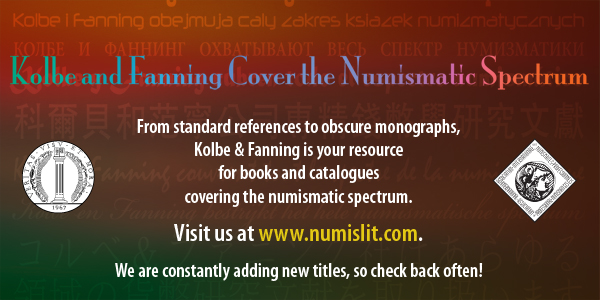
BOOK REVIEW: THE WISHFUL PENNY
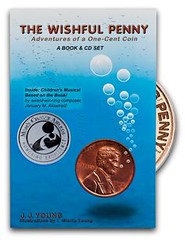 Rosie was not just a riveter during World War II but she also worked at the U.S. Mint in Philadelphia making blanks for coins.
Rosie was not just a riveter during World War II but she also worked at the U.S. Mint in Philadelphia making blanks for coins.
Working in the blanking room at the U.S. Mint was not an easy job. It was hot, loud, and Rosie was confused. Even though she was supposed to feed a sheet of zinc coated steel into the blanking press, Rosie fed a sheet of copper. With the press of a button, 40 copper blanks were made.
Rosie panicked. The president ordered that the U.S. Mint not use the copper for coins so it could be used for the war effort. Not knowing what to do, Rosie let the coins proceed to the next stations where they were washed and “pinched” to create rims keeping her fingers crossed that nobody found out.
The copper blanks were fed into the press along with the zinc-coated steel blanks and thus was born Penny, a 1943 copper cent.
The Wishful Penny is the story of Penny’s adventure from her accidental birth, to an ice cream shop, across the Atlantic, back again, and how one wish made on Penny comes true.
Written for readers in grades 3-5 with a story that can be appreciated by younger students, The Wishful Penny written by J.J. (Jennifer Jo) Young.
The use of factual information makes the story more appealing. Forget the fact that I am some-number-of-many-years beyond the target age group for this book, it has the ability to not only teach the students but also the teachers who may have not thought about using coins as a teaching tool. If a teacher wants to use this book for classroom instruction, the authors offer a teacher’s kit that includes books, worksheets, discussion questions, activities, history tie-ins, and script with a CD of music to allow the students to perform the book as a play.
I did not know what to expect when I agreed to review this book. But I was surprised how engaging it was even for a “vintage” person like me. Even though Penny ends up at less than an Mint State (MS) grade by the end of the book, I grade this book MS68 with a recommendation that if your young reader does have reading difficulties also purchase the audio CD. In fact, you may want to consider purchasing the teacher’s kit and donate it to your child’s school. Or for the classes looking to put on a play, why not consider the full-length musical with recorded music. It has to be a great idea for teachers needing new material!
For more information, or to order, see: The Wishful Penny... a Book & CD Set! (seethewish.com/indexTWPJPset.html)
To read the complete article, see: REVIEW: “The Wishful Penny” should delight your young reader (coinsblog.ws/2013/09/review-the-wishful-penny-should-delight-your-young-reader.html)
O NVMISMATA (THE NVMISMATIST) NO. 2 PUBLISHED
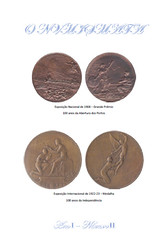 O NVMISMATA Nº2 (The Nvmismatist nº2) has been sent to the AVBN (The Brazilian Virtual Numismatic Association) members on Sept. 5th.
O NVMISMATA Nº2 (The Nvmismatist nº2) has been sent to the AVBN (The Brazilian Virtual Numismatic Association) members on Sept. 5th.
In this 30-pages issue, alongside AVBN news, you can read about:
- Brazilians numismatics associations, past and present;
- The United Kingdom of Brazil, Portugal and Algarve (history and coinage);
- Ephraim Brasher and the Brazilian gold;
- Vermont State Coinage; and
- The "Banco do Café" banknotes.
Most articles are in Portguese, but the "Vermont State Coinage" article is in English.
You can find out more about O NVMISMATA and the AVBN (and become a member with only US$10,00/R$15,00 per year) in www.avbn.net.
Numismatics greetings to all,
R. Leite
AVBN President in office
For more information about AVBN, see: www.avbn.net
ERIC VON KLINGER, 1946 - 2013
Civil War Token Society Governor Jud Petrie writes:
I regret to inform everyone of the death of my friend Eric Von Klinger on August 22, 2013. Eric was CWTS member #0896, a charter subscriber to Coin World in 1960, and spent many years writing for that publication with the 'Readers Ask' column. He assisted me on the Literary Awards committee for the CWTS.
 I used to look forward to seeing Eric at the ANA every year. When he came down with cancer he ended up selling most of his collections as well as his numismatic literature. As the cancer went into remission, he regretted selling his books the most. He came to Maine 2 years ago and was in fine health at the time. We went to Acadia National Park as well as some of the ports where he enjoyed seeing the old 'windjammer' sailboats.
I used to look forward to seeing Eric at the ANA every year. When he came down with cancer he ended up selling most of his collections as well as his numismatic literature. As the cancer went into remission, he regretted selling his books the most. He came to Maine 2 years ago and was in fine health at the time. We went to Acadia National Park as well as some of the ports where he enjoyed seeing the old 'windjammer' sailboats.
Eric was a wealth of information and a real nice guy. I feel honored to be considered one of his friends.
 Former Coin World staff writer Eric J. von Klinger died Aug. 22 after a lengthy battle with cancer.
Former Coin World staff writer Eric J. von Klinger died Aug. 22 after a lengthy battle with cancer.
He was 66 years old.
Born Oct. 8, 1946, in Wilmington, Ohio, Mr. von Klinger was the son of World War II veteran Joseph von Klinger, a pharmacist and lawyer, and Louise Valla von Klinger Kircher, a homemaker, both of whom preceded him in death.
Mr. von Klinger, an expert and researcher in error coins, authored the Collectors’ Clearinghouse and Readers Ask columns during much of his six years on staff, from early 2002 to mid-2008.
Prior to joining Coin World, Mr. von Klinger served in writing and editing positions at daily newspapers in Indiana, North Carolina, Ohio, Pennsylvania, Utah and West Virginia. He was also a veteran numismatic journalist. From 1993 to 1996 he served as an associate editor for Numismatic News and as a writer for Coins magazine.
While growing up in Wilmington, Ohio, he got his first exposure to numismatics. When the Lincoln, Lincoln Memorial cent was first released in 1959, Mr. von Klinger’s seventh-grade science teacher brought a roll of the newly minted coins to the classroom, giving a cent to each student. An intrigued von Klinger remembered that his father had a bag of old coins, and he began examining those coins, beginning a lifelong hobby.
His interests grew to encompass nearly every area of United States coins, early American coppers and tokens, as well as world coins.
Mr. von Klinger was a charter subscriber to Coin World, which was first published in April 1960.
Mr. von Klinger earned a bachelor’s degree in English from Miami University of Ohio, where he also pursued graduate studies in English.
He was a member of the American Numismatic Association, Civil War Token Society, and Token and Medal Society.
He is survived by two nephews, Mike (Jenny) Smuland and Matt (Phyllis) Smuland, and former wife Shawnee (Mark) Culbertson.
A private graveside service was held at Sugar Grove Cemetery in Wilmington, Ohio.
ANS SYMPOSIUM ON EARLY ELECTRUM COINAGE NOVEMBER 2013
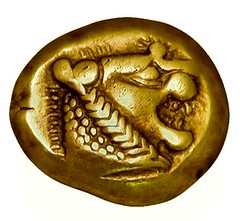 The Beginning of Coinage:
The Beginning of Coinage:
New Discoveries and Research on Early Electrum Coinage
On 15-16 November 2013 a symposium on early electrum coinage will be held at ANS headquarters at 75 Varick Street, floor 11, New York NY 10013.
There are 35 spaces available for this event, and early booking is recommended.
Hotel room-blocks for participants are available at the nearby Hampton Inn Manhattan-Soho and the Washington Square Hotel. However, both hotels have cut-off dates. For the Washington Square Hotel, rooms must be booked by 11 September 2013 and for the Hampton Inn Manhattan-Soho, rooms must be booked by 14 October 2013.
Questions or to make payment arrangement via telephone call Membership at 212-571-4470 ext. 117. Email inquiries to membership@numismatics.org
This symposium offers members and others interested in early electrum coinage to learn more about new discoveries in the field that shed light on a variety of questions surrounding the coins. For example: What are they made of, and how? When were they made, and why? What can they tell us about the economy and society of the people who produced them?
Papers by international experts in the field will cover a variety of aspects. These will include a discussion by the excavator of the Archaic Artemisium at Ephesus of the archaeological finds and their impact on the dating of electrum coinage; a presentation on the chemical analysis of over 100 coins from the cabinet of the Bibliothèque Nationale in Paris and the American Numismatic Society. These analyses, carried out at Centre Ernest-Babelon in Orléans and at the Field Museum in Chicago using microsampling by laser ablation, have enabled us to see more accurately than ever before the composition of the first coins. T
he question of why, how and when electrum was used for the first known coins will be at the center of the discussion by a series of eminent historians economists and numismatists. The symposium will conclude with discussion to which all attendees are invited to contribute.
The symposium will be accompanied by a display of electrum coins from the ANS cabinet. Coins from the ANS collection will also be available for examination.
For more information, see: The Beginning of Coinage (numismatics.org/NewsEvents/Electrum)
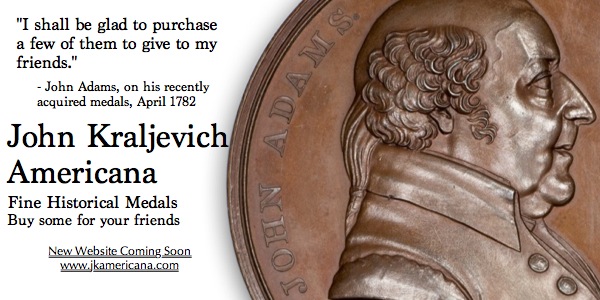
AN AUTHOR'S EXPERIENCE: CREATESPACE AND AMAZON.COM
About my book
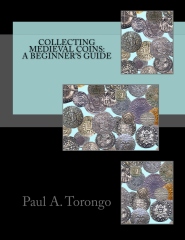 My name is Paul Torongo. I have been an on-again-off-again, amateur collector of coins my entire life. As a child, I naturally began by collecting the coins of my native United States. However, American coins never really appealed to me; I much preferred British coins, with their heraldic motifs. I thought the Queen Victoria "gothic" crown was the most beautiful coin I had ever seen. Back then, I erroneously believed that the medieval coins I saw in Seaby's Coins of England (1973) were only to be found in museums or the collections of the rich and famous.
My name is Paul Torongo. I have been an on-again-off-again, amateur collector of coins my entire life. As a child, I naturally began by collecting the coins of my native United States. However, American coins never really appealed to me; I much preferred British coins, with their heraldic motifs. I thought the Queen Victoria "gothic" crown was the most beautiful coin I had ever seen. Back then, I erroneously believed that the medieval coins I saw in Seaby's Coins of England (1973) were only to be found in museums or the collections of the rich and famous.
Fast forward several decades to 2003 and one would find me living in the Netherlands with my Dutch wife, and collecting the coins of my new homeland. While attending a coin show one day, I was astonished to find a shilling of Queen Elizabeth I, then the closest thing to a medieval coin I had ever seen "in the flesh". This find encouraged me to start attending more Dutch coin shows, and sure enough, those medieval coins started popping up one after the other! (My Elizabeth shilling long ago sold off as "non-medieval".)
At that point I was much akin to a kid in a candy store, avidly snapping up every medieval coin I came across. Those of you familiar with medieval European coins will know that they are unlike any other sorts of coins: they can often be difficult to identify, almost impossible without a reference work by your side. The legends are usually in Latin, and the strange letter forms on the coins can be confusing and misleading. It quickly became clear that I needed a book to help me. (Bear in mind that in 2003 the Internet was of little use to the collector of medieval coins.)
As I began to look around for a helpful book on medieval coins, it soon became evident that there simply was none. The collector is faced with a multitude of books very specific to a particular geographical area or type of coin. Most of these books are deep, scholarly works, written with the idea that the reader already knows a great deal about medieval coins. On top of that, most of these books are expensive and/or hard to find (see, for example, the new volume of Medieval European Coinage, which will set you back some $200). A simple, easy-to-use, yet informative guidebook for medieval coins did not exist, and so I decided to write one myself. So that's what I did -- it only took ten years to get it done.
My experience with CreateSpace
A book about collecting medieval coins is probably not destined to be the world's next bestseller, and so finding a publisher was no easy task. In the end, I decided on the Self-Publishing route. Probably the most well-known website to publish your own book is Lulu.com. I ordered a "test book" that had been printed by Lulu.com, but when it arrived I found the photographs to be of very poor quality. I contacted the author to politely ask if the poor photos had been provided by him, or had been degraded by Lulu.com. Sadly, I never received a reply (I hope he wasn't insulted), so I could not place the fault for the poor photos. For me, this left Lulu.com out, so I moved on to Amazon.com's CreateSpace, which how I eventually published my book Collecting Medieval Coins: A Beginner's Guide in 2013.
The entire CreateSpace experience had its ups and down, shall we say. I can certainly recommend this route to those who wish to publish a book, as long as you don't particularly care about earning any money from it. If you just want to get your book out there, CreateSpace is certainly a viable option.
CreateSpace was able to produce a print-on-demand book that can be ordered directly from CreateSpace, or via one of the Amazon.com sites. The book itself is rather nice, and I am quite happy with it. (They only do paperbacks; b/w or full-color.)
However, since no one has heard of CreateSpace, everyone will naturally be buying your book via Amazon. This means that when CreateSpace promises me $12.15 royalties for each book sold via CreateSpace and only $2.15 per book sold via Amazon, well I'm never REALLY going to get a $12.15 royalty, am I? It's like a carrot dangled before my nose.
CreateSpace informs me that my book will cost $28 to produce, which is about the price of an "author's copy" if I want one. (DO NOT purchase an "author's copy" -- read on...). Based upon this, I chose to price the book at $40. (This is more than I wanted to charge, but printing color photographs is expensive). At the very last moment, literally two "clicks" away from publishing the book, I was FORCED by CreateSpace to ask $50 for my book (thus making it less attractive to potential buyers). This gave me a rather uncomfortable feeling, but I continued on. (Prices set "by me" at this point: $ 50, € 45, £ 35.)
The very first thing Amazon.com did was to offer my book for $47.50, thus ensuring that no one would order the book for $50 from CreateSpace, thus further ensuring that I would never get a $12.50 royalty (uncomfortable feeling grows slightly).
Within only two months, Amazon dropped the price to $15.48 (!). Now, since my $2.15 royalty stays the same either way, this would seem to be beneficial to me: a lower price means more sales, right? Right. Unfortunately, my concurrent self-promotion campaign was cut off at the knees. Look at the lovely entry in The Esylum newsletter for example. Would the reader and myself not have been better served by seeing a nice, low $15 price instead of $47.50? Too late now!
The price of a CreateSpace "authors copy" remains about $28; this means it would be MUCH cheaper for me to order a copy for myself via Amazon.com. This seems very odd to me. I cannot understand how Amazon can sell a print-on-demand book for almost half the cost price and still stay in business. (Unless, of course, CreateSpace simply lied about the cost price.) And in case you're wondering, as of this writing my book sells on Amazon Germany for € 48, while it only costs € 15 on Amazon Italy. (Amazon UK price down from £35 to £23). No, I cannot explain it.
The entire exercise of setting a price at CreateSpace seems to have been a farce. Other than the uncomfortable feeling they gave me, and the annoying confusion caused me by the inexplicable Amazon pricing policy, I suppose everything worked out fine.
As long as I don't think about it too much.
To read the earlier E-Sylum article, see: NEW BOOK: COLLECTING MEDIEVAL COINS (www.coinbooks.org/esylum_v16n36a10.html)
KARL MOULTON ON THE "GREAT DEBATE" TAPES
When I was doing research about John J. Ford, Jr., I inquired to the American Numismatic Association about the "Great Debate" tapes made by the ANA in 1999, and was told they were "missing". This includes the two made on Saturday, and one which was made on Sunday. I had attended the 1999 debate and had to leave on Saturday, so was unable to attend the Sunday session by John Ford; hence the inquiry.
In the Ford/"Franklin Hoard" book, there is a section on the "Great Debate" (pgs. 755-761), and I did use the Saturday tapes which were in my library, to quote a passage between Harvey Stack and Ted Buttrey; along with the closing comments by Ford to Buttrey (both quoted in the book). I also presented an appeal for the return of the "borrowed" tapes to their rightful owner, the American Numismatic Association.
I believe my research was the key in finding out these tapes were no longer available for review from the ANA, and also believe that Elizabeth Hahn was correct in her belief that the American Numismatic Society is the only numismatic organization that now has a copy of these tapes.
The "Great Debate" tapes were not used to validate or refute anything Ford mentioned regarding the authenticity of the material. On Saturday, he kept silent until the very end and then only said a few rather libelous things to Buttrey. The John J. Ford/"Franklin Hoard" book was not written to authenticate or condemn any of the material, as it was primarily concerned on the objective presentation of the background issues surrounding the lengthy controversy.
To read the earlier E-Sylum article, see: NOTES FROM E-SYLUM READERS: SEPTEMBER 1, 2013 : Great Debate Tapes (www.coinbooks.org/esylum_v16n36a16.html)
THIAN'S REGISTER OF THE CONFEDERATE DEBT
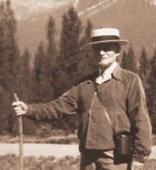 Today, Confederate Paper Money collectors hold Raphael P. Thian in the highest of regards. Specialists pour over the reprint edition of his Register of the Confederate Debt, and originals of that rare book sell for the tens of thousands of dollars. Thian’s Register is frequently mentioned on lists of “rarest” or “most important” numismatic works, and when a new example is discovered it rates a front-page story on the cover of Bank Note Reporter.
Today, Confederate Paper Money collectors hold Raphael P. Thian in the highest of regards. Specialists pour over the reprint edition of his Register of the Confederate Debt, and originals of that rare book sell for the tens of thousands of dollars. Thian’s Register is frequently mentioned on lists of “rarest” or “most important” numismatic works, and when a new example is discovered it rates a front-page story on the cover of Bank Note Reporter.
However, Thian died in relative obscurity in late 1911. When he did so, most of his personal Confederate volumes came into the possession of his younger son, Prosper E. Thian,
He contacted cataloger Philip Chase, Duke University in Durham, N.C., and other parties he thought likely to be interested in such materials. Chase who was in the process of writing his own Confederate note catalog to follow up on his 1936 pamphlet was a particularly astute choice for Thian.
Some of this material eventually came into possession of the Smithsonian Institution. According to the recently departed Smithsonian Numismatic Curator Dr. Richard Doty, who was a friend and colleague for nearly 40 years: “We have the two volumes (of Thian notes), plus correspondence between Thian’s son, P.E. Thian, and Philip Chase, mostly letters from Thian. Thian was selling Chase notes from time to time. All of this correspondence takes place during mid-February through early July 1945.
To read the complete article, see: Baton Passes to Thian, Bradbeer (www.numismaster.com/ta/numis/Article.jsp?ad=article&ArticleId=27197)

Rare U.S. & Worldwide Banknotes, Scripophily and Autographs
“The Copps Collection” of Colonial Stocks, Bonds, Documents & Fiscal Paper to be held in conjunction with the 3rd Annual Wall Street Coin, Currency & Collectibles Show.
Highlights include:
- From “The Copps Collection”, A 1792 U.S. Federal Bond Issued to and Signed by George Washington, this is one of three known, the other two are in an institutions, this is the first time ever at auction
- U.S. Colonial; Obsolete; Fractional; and, Large Type Notes including a high grade “Educational” Set of 3 notes along with dozens of other rare banknotes.
- Worldwide Banknotes including an outstanding U.A.E. Specimen Set as well as hundreds of other rare and desirable notes.
- Hundreds of U.S. & Worldwide Stocks and bonds including autographed certificates and autographs by Daniel Drew; Thomas Edison; Buffalo Bill Cody, Robert Morris and many others.
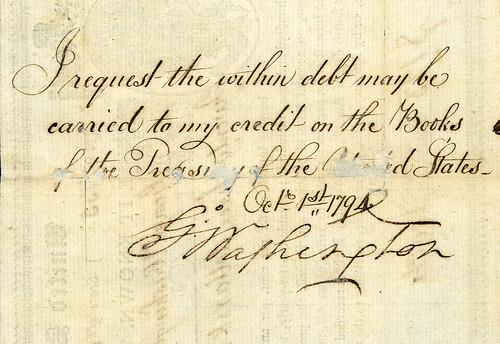
1580 Lemoine Avenue, Suite #7
Fort Lee, NJ 07024
Phone: 201-944-4800
Email: info@archivesinternational.com
WWW.ARCHIVESINTERNATIONAL.COM
MORE ON EXCHANGING DEMONETIZED MONEY
Juan Carlos Harris of Mexico City writes:
Banco de México will redeem all obsolete banknotes, issued by the Bank, and that are not used anymore in trade.
For notes issued between 1932 and 1992, because of the hyperinflation that occurred in those days, the Bank will accept the note and redeem it in current pesos, that is, with three zeros less (a $10,000 peso note of those days will become $10 current pesos, or $100 pesos from those days, will become 10 cents).
The notes from the New Pesos period (1992-1996) will simply be exchanged on a 1:1 basis (100 new pesos note from 1995 is 100 pesos from 2013).
And taking about coins: coins in cents and pesos are legal tender for all PRIVATE debts as long as they aren't in excess of 100 pieces of each denomination (say, you can pay someone with 100 pieces of $5 and 100 pieces of $10). All government offices (taxes, customs, and so on) are obliged to accept coins in any amount (it would be nice, just to bother, to pay them with 20000 pieces of 10 cents).
To read the earlier E-Sylum article, see: DEMONETIZING OLD CURRENCY (www.coinbooks.org/esylum_v16n35a12.html)
ALUMINUM WRONG PLANCHET ERRORS
Aluminum planchets were once considered an alternative to copper for cent production by the U.S. Mint. Many collectors may remember the 1.5 million 1974 Lincoln cents that were struck in aluminum. The entire production was rejected and all coins were recalled. One specimen exists legally and resides at the Smithsonian Institute.
A second specimen, known as the Toven specimen, is detailed in a story written in July 2005 by the late Alan Herbert for Numismatic News. Slabbed by ICG, Herbert suggests that it is likely worth several million dollars, if not more.
Many mints around the world strike coins using aluminum planchets. It is always exciting to encounter errors struck on a wrong planchet and this article focuses on several having been struck on aluminum.
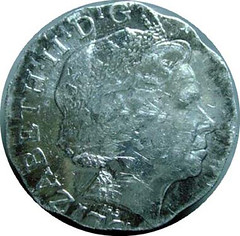
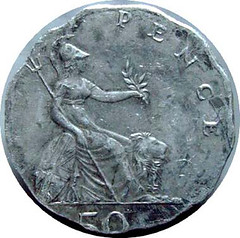
British no date 50 pence coin struck on a 12 sided aluminum planchet weighing 0.8 of a gram.
The first error is a 50 pence from Great Britain. A normal 50 pence from this time period is seven sided and weighs 8.0 grams. In 2007 I came upon this 50 pence struck on a scalloped, 12-point aluminum blank weighing 0.80 of a gram. After some tidy research I found a likely match. I believe this blank was intended for a 1c coin from Belize. A normal 1c from Belize has a scalloped, 12-point perimeter and has a specification weight of 0.80 of a gram, an exact match for the weight of this error coin.
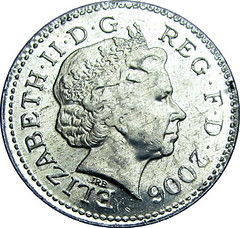

British 2005 5 pence struck on aluminum planchet.
The second error carries the design of a 2006 5 pence from Great Britain. This particular design began production in 1995 and continues to the present day. A normal 5 pence weighs 3.25 grams. This wrong planchet error weighs 0.70 of a gram and is struck on a circular aluminum disc. I have yet to determine which country this aluminum planchet was intended for.
For more information on The Combined Organizations of Numismatic Error Collectors of America (CONECA),, see: http://conecaonline.org/
MORE ON SILVER PLUGS IN SILVER COINS
The dealer friend of mine assured me that indeed the piece was a silver plug and it belonged to an elderly woman who traveled to Europe in the 1960’s. There she befriended a man who gave her and her daughter each a silver dollar. Her daughter received a Seated or Trade Dollar which was long gone but she hung on to the Bust Dollar she was given until now. With her house needing mending she was deciding to finally sell it. Being wary of its veracity I gave him some diagnostics to check for on a truly plugged dollar visa-vis a repaired piece.
The following week he called and said “it’s in my case”, so I whistled back up to the flea market where he sets up on Wednesdays for an in-person look. And sure enough not only was it truly a silver plugged dollar but also it was a very nice example of one. A Fine 15 or VF20 example with not only a silver plug but one of the most visual silver plugs I have ever seen. Unfortunately some light graffiti was scribed across the obverse “ W.H. Davis Elmira, NY”. But the graffiti is contemporary, lightly engraved and has toned nicely with the natural patina of the coin. Interestingly, parts of the graffiti were scribed over the plug itself.
After each planchet was individually weighed the heavy ones were simply filed into specification and struck as-filed, leaving behind what are known as “Adjustment Marks”. Examples of adjustment marks on early US silver and gold issues are ubiquitous. What to do with underweight planchets was a whole different paradigm, as augmenting weight is much taller task than grabbing a hasp and filing away a few grains.
But examples exist, most notably on Bust Silver Dollars like my example shown, and to a much lesser extent Bust Half Dollars. The earliest known example is a 1794 Silver Dollar which recently auctioned off for a record $10 Million through a Stacks Bowers Auction. To date it is not known on gold issues. Augmenting weight on a single planchet was at the very least a cumbersome ordeal, a labor intensive procedure that by today’s manufacturing standards view would be considered simply laughable in scope.
But in the early Mint days it is now known that underweight blanks would be re-directed to a Mint technician who would then pierce from the center of the blank a hole, measuring roughly 5 mm in diameter. At his disposal were various silver strips, all of thicker but varying gauges (thicknesses), allowing him a selection to punch a perfect plug that upon successful insertion would bring the planchets weight into specification.
The same mandrel that was employed to blank out the hole of the planchet was employed to punch the strip used for augmentation. The technician would then manually insert the plug into the planchet, most likely with the use of a simple hammer. The thickness of the plug selected was based on how much underweight the planchet was—the more underweight the heavier the gauge strip selected.
In some cases the plug is known to be just slightly heavier than the holed area. In other cases the plug is significantly thicker than the existing planchet. In these cases it is observed that after successful insertion the silver plug was then hammered down to lay flat with the planchet surface to accommodate future striking. A plug that sticks well above the surface of the planchet would render it impossible to strike.
There was a time when the silver plugged dollars of 1795 were considered an undesirable anomaly, a difficult sale to the collector—but no longer. In today’s market silver plugged dollars are in ready demand and bring multiples of the standard issue.
The example was subjected to a number of metallurgical evaluations to help shed light on its nature.
The results clearly showed that the silver content of the plug was virtually identical to the host coin itself, so the reason for the plugging was clearly not the fineness level of the host coin. A scan showing actual silver content of the area just left of the plug and then through the seam and into the plug itself is shown in the attached graph. The large dip in silver content corresponds to the seam.
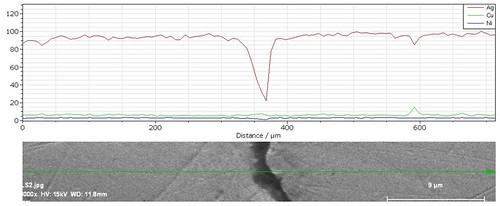
We then subjected the coin to a 3-D X-ray imaging analysis, and although I do not have the images to share at this time the plug’s morphology is very similar to a rivet; the outside diameter of the plug being 10mm and the center core diameter being 5mm, suggesting a long plug was hammered into place to add weight to a light blank.
Although the theme of this letter is not our beloved copper Indian or Flying Eagle, it is a great example of history, numismatics and researching coming together for a fascinating study.
To read the earlier E-Sylum article, see: ON SILVER PLUGS AND SILVER COINS (www.coinbooks.org/esylum_v16n36a21.html)
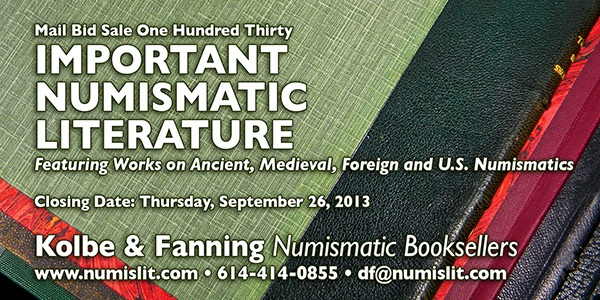
WERE WALTON'S COINS REALLY SCATTERED ON THE HIGHWAY?
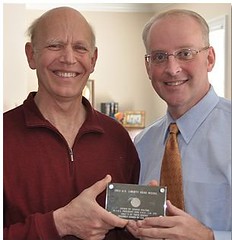 I write to set the record straight, hopefully once and for all, concerning the question of whether George Walton's coins were "scattered all over the highway" after his fatal car crash. It was widely, and wrongly, reported at the time that this was so; apparently numismatists aren't the only ones who don't let facts stand in the way of a good story. Many people's recollections are probably based on all of that inaccurate reporting at the time of Walton's untimely death.
I write to set the record straight, hopefully once and for all, concerning the question of whether George Walton's coins were "scattered all over the highway" after his fatal car crash. It was widely, and wrongly, reported at the time that this was so; apparently numismatists aren't the only ones who don't let facts stand in the way of a good story. Many people's recollections are probably based on all of that inaccurate reporting at the time of Walton's untimely death.
I had the great pleasure of interviewing Ryan Givens, Walton's nephew, back in February 2013 for the Heritage offering of his family's famous 1913 Liberty nickel. While others at Heritage had known Givens much longer -- particularly Mark Borckardt — it was a signal honor for me to get to know this modest, charming man and help the Heritage team relay his uncle's story in what we believe to be a faithful and accurate manner.
The words of Ryan Givens from the Heritage catalog should suffice:
George Walton's nephew, Ryan Givens, was interviewed specifically for this tribute to his uncle and his remarkable, storied nickel in February 2013. Givens said he believes his uncle was actually carrying around $90,000 worth of coins at the time of his death, and that the reported figure of a quarter-million dollars is an exaggeration. "The story grew in the telling, but it wasn't true." Givens said. "Even Uncle George wouldn't have carried that much around at one time. But $90,000 was a ton of coins back in 1962. And he had the nickel, which he didn't show all the time, but he had the nickel. It was recovered, still in its plastic holder."
Police arriving at the scene identified Walton from a newspaper clipping and realized the coins were valuable. All of the coins he carried were recovered and impounded for the estate in a local bank vault. Most of Walton's coins, including many more that did not accompany him on his fatal drive, would be auctioned by Stack's. Unfortunately, later in 1962 the famous Walton 1913 Liberty nickel would be returned from Stack's, which had consulted with unidentified "authenticators" at the ANS who pronounced the coin a counterfeit -- incorrectly, as it turned out much later, in 2003.
Givens added, "Another part of the story that is untrue is that the coins were scattered across the highway after the wreck. When the nickel was 'missing,' they would all go down where they thought the accident was and look around on the ground, because they thought it might be there. But according to the bank, none of it was scattered on the highway. It was still in the car."
"Especially when the nickel was 'missing,' then you think, 'Well, OK, where is it? It was in a wreck; it might have come out of the car.' And people work that. But people still quote that, that the coins were scattered along the highway. I just saw it the other day in one of the stories. There are parts of the story that will stay out, no matter what. I believe it was John Dannreuther who said, 'In the numismatic world, somebody says something and it becomes fact. When it's repeated, it becomes absolute fact.'
To read the earlier E-Sylum articles, see:
QUERY: WERE WALTON'S COINS REALLY SCATTERED ON THE HIGHWAY?
(www.coinbooks.org/esylum_v16n34a16.html)
ACCIDENTAL FORTUNE: THE WALTON 1913 NICKEL EPISODE
(www.coinbooks.org/esylum_v13n21a21.html)
HARVEY STACK ON THE JOHN J. FORD COLLECTION SALES
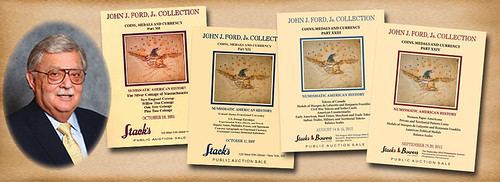
John got a great deal of information and training from Richard Picker and Ted Craige, superb collectors and dealers in early Americana. Harvey remembers being taught by John about die varieties, early American colonial issues, territorial and pioneer items and the history of broken bank issues. Norman also learned and benefited from his teaching. Sometimes his explanations were long but always loaded with detailed facts. John also helped Q. David Bowers develop his abilities in Americana and numismatic research, areas in which he became very proficient.
John championed many a numismatic debate, doing weeks of research in preparation and then smothering the opposition with facts. He wrote many articles and often lectured at local coin clubs. Larry Stack, my son who joined Stack’s full time in 1973, was an early student and devotee of John. John had such a wealth of knowledge that discussions between Larry and John often lasted for hours. Larry attributes his current expertise to the days spent with John in combination with training by the Stack’s elders.
Because of health reasons, in the 1980s John’s wife, Joan, suggested they move to Arizona where the dry weather would help her lung problems. John meticulously packed all of his collections, wrapped items in special tarnish-proof paper (which he searched out for months before using), and moved with her to Arizona where he lived until his passing in 2005.
The 24 catalogs meticulously prepared by Stack’s and Stack’s Bowers Galleries are a composite of all the wonderful coins, medals and currency that John assembled over 60 years. The Stack family assigned certain of the research and writing to Michael Hodder, a prodigy of John’s, who came to work with Stack’s in the late 1980s. Together with Larry and Harvey (and other team members) they prepared the earlier catalogs which will be forever remembered as essential references. Dave Bowers and Bruce Hagen made numerous contributions for the catalogs and helped make this suite of catalogs on numismatic Americana the most valuable ever produced. And, as I write these words, the John J. Ford Jr. Collection itself has become THE most valuable United States coin collection ever sold, with prices realized from our previous two catalogs pushing the grand total over $59.5 million! And there is still more to come!
To read the complete article, see: Remember When: One Of The Greatest Collections Of The Twentieth Century (stacksbowers.com/Blogs/remember-when-one-of-greatest.html)
MORE ON JOHN MAYNARD KEYNES AND YAP STONE MONEY
 Keynes does reference the phenomenon of Yap money in a footnote on pg. 292 of the second volume of A Treatise on Money (McMillan and Co. 1950, first published 1930). In the relevant passage, Keynes was making a point about how the function of gold in modern monetary management had been increasingly confined to a standard of value. Paradoxically, while gold was revered by its supporters as a tangible commodity, its actual monetary significance was henceforth to serve as an abstraction. As Keynes wrote about gold in his typically arch style:
Keynes does reference the phenomenon of Yap money in a footnote on pg. 292 of the second volume of A Treatise on Money (McMillan and Co. 1950, first published 1930). In the relevant passage, Keynes was making a point about how the function of gold in modern monetary management had been increasingly confined to a standard of value. Paradoxically, while gold was revered by its supporters as a tangible commodity, its actual monetary significance was henceforth to serve as an abstraction. As Keynes wrote about gold in his typically arch style:
"It no longer passes from hand to hand, and the touch of the metal has been taken away from men's greedy palms. The little household gods, who dwelt in purses and stockings and tin boxes, have been swallowed by a single golden image in each country, which lives underground and is not seen. Gold is out of sight--gone back again into the soil. But when gods are no longer seen in a yellow panoply walking the earth, we begin to rationalise them; and it is not long before there is nothing left" (p. 291).
I think Keynes had his ideas, and the stone money of Yap simply provided him with yet another deft way to illustrate his argument. There is also a highly interesting discussion of the Yap example on the blog Moneyness: http://jpkoning.blogspot.com/2013/01/yap-stones-and-myth-of-fiat-money.html
To read the earlier E-Sylum article, see: NOTES FROM E-SYLUM READERS: SEPTEMBER 1, 2013 : John Maynard Keynes and Yap Stone Money (www.coinbooks.org/esylum_v16n36a16.html)
THE BOOK BAZARRE
ARTICLE EXPLORES: ARE BANKNOTES SEXIST?
Are banknotes sexist? Recently, the Bank of England has announced that popular novelist Jane Austen is to appear on the new £10 note. This followed in the wake of much controversy over previous news that Elizabeth Fry is to be ousted from the fiver.
Since then women rights activists have been campaigning to celebrate more female achievements on our banknotes. You could point out that our notes do have a portrait of the Queen on all of them, but otherwise only one woman was featured at any one time. But how is it in other countries?
Lets take a look, for example, at currency from our favourite holiday destinations.
Most countries have no women represented on their banknotes at all. Out of the 14 countries listed in the table below only 11 per cent of banknotes include an image of a woman. It’s not as bad as it sounds though. Some designs like the Euro don’t include people at all, depicting famous architecture instead.
A lot of countries also choose to use an image of their current leader. This includes the Chinese Yuan, Saudi Riyal, Russian Ruble, the Turkish Lira and of course our very own Pound.
Other countries like the United States have chosen to print influential political figures on their notes. The dollar most famously depicts Benjamin Franklin, Abraham Lincoln and other founding presidents. To this day there hasn’t been a female US president and until that happens we probably won’t be able to expect to see a women on dollar bills.
Of course, some feminists will rightly point out that since banknotes were introduced there have been women in our history whose achievements are banknote worthy. Look at Australia, for example. There are currently six females depicted on the Australian Dollar where there is only one note without female representation. In fact, most Australian Dollar notes have both a man and a woman on them. Now that’s gender equality for you!
To read the complete article, see: Are banknotes sexist? We look at folding stuff from top travel spots to find out (www.mirror.co.uk/lifestyle/travel/banknote-designs-top-travel-destinations-2234051)
MORE ON THE LEGAL TENDER STATUS OF U.S. COINS
What is a legal tender coin or piece of paper money, and what does it mean? Essentially that it must be accepted by the population for a debt (i.e., a coin or paper money or similar that is a substitute for evidence of debt, public and private;
Two recent events bring this to the forefront.
First is a letter to the Huntsville (Alabama) Times on March 8, 2006 which recites how a person “was recently purchasing gas at Kroger on Hughes Road in Madison when I noticed a sign on the pump notifying customers that "rolled coins" and "loose change" could not be accepted as payment. Isn't a business required to accept any form of legal U.S. currency as payment, or can it set its own guidelines for what can be used for payment?”
The answer provided by the newspaper said “No, there is no law that says a merchant must take any particular kind of currency, said Michael White, spokesman for the U.S. Mint. Businesses are free to set their own guidelines as to what they accept as payment, he said.”
There’s an amplification on the Treasury Department’s web site. They as the question a different way, but point to the same answers. ON the web site, the parry says “I thought that United States currency was legal tender for all debts. Some businesses or governmental agencies say that they will only accept checks, money orders or credit cards as payment, and others will only accept currency notes in denominations of $20 or smaller. Isn't this illegal?”
Responding, Treasury says “The pertinent portion of law that applies to your question is the Coinage Act of 1965, specifically Section 31 U.S.C. 5103, entitled "Legal tender," which states: "United States coins and currency (including Federal reserve notes and circulating notes of Federal reserve banks and national banks) are legal tender for all debts, public charges, taxes, and dues."”
They go on to explain that “This statute means that all United States money as identified above are a valid and legal offer of payment for debts when tendered to a creditor. There is, however, no Federal statute mandating that a private business, a person or an organization must accept currency or coins as for payment for goods and/or services.”
Summarizing its position. Treasury goes on to say that “Private businesses are free to develop their own policies on whether or not to accept cash unless there is a State law which says otherwise. For example, a bus line may prohibit payment of fares in pennies or dollar bills. In addition, movie theaters, convenience stores and gas stations may refuse to accept large denomination currency (usually notes above $20) as a matter of policy.”
Actually, the citations to federal statutory sources are correct, and so are the examples cited – because they are examples of real-life cases that have been decided for the propositions stated. But they ignore the history of what legal tender mans, what in fact “legal tender” really means, and why laws about them were created in the first place.
There are two constitutional issues that are useful to discuss what the words mean. First, is Article I, Section 8 of the Constitution, which provides "The Congress shall have Power ... To coin Money, regulate the Value thereof, and of foreign Coin, and fix the Standard of Weights and Measures...."
Next is from Article I, section 10, which reads, "No state shall ... coin Money' emit bills of Credit; make any Thing but gold and silver Coin a Tender in Payment of Debts...."
Courts have consistently held that neither of these provisions of the Constitution renders the country's current money system unconstitutional, staring with the Legal Tender Cases in 1884.
Those cases involved the ultimate political gamble: creation of paper currency at the height of the Civil War, designed to fund the effort. Its inventor: Salmon P. Chase, Secretary of the Treasury. When accomplished, the federal government reportedly had three days in funding in its vaults; thereafter, it printed what it needed.
Not without critics in its time, Lincoln knew that there was an ultimate Supreme Court battle shaping up; so, too, was there a battle over his Emancipation Proclamation. The legacy of his presidency depended on both being sustained, and when Chief Justice Roger Taney died, Lincoln nominated a known abolitionist, Chase, to both sustain the Emancipation and the greenbacks.
In its original appearance before the Court, Chase prevailed in his view; the surprise is that he found his actions unconstitutional and in a close 5-4 vote, the Court agreed. By now it was the Grant administration, and he persuaded two justices to retire; their replacements switched votes on the reargued case, and the power to declare paper money a legal tender was sustained.
Legal tender ultimately is the power of compulsion. It means that the government can require you, willingly or not, to accept a type of money that is tendered. That’s why state-authorized private banknotes were an ultimate failure and sold at discounted prices that were disparate.
Over the years, there have been many challenges to what legal tender means; few recall that prior to 1857, foreign coins circulated freely in the United States. The act of Feb. 21, 1857, (ch. 56, 11 Stat. 163 ) determined that the legal tender of the Spanish pillar dollar continued but for other foreign coins, legal tender status was denied.
Over the years, even recently, there have continued to be legal challenges to what constitutes a legal tender. In Foret v. Wilson, 725 F.2d 254 (5th Cir.1984), the Court dismissed the plaintiff's argument that only gold and silver coin may be constituted legal tender by the United States.
In another case, Edgar v. Inland Steel Co., 744 F.2d 1276, 1277 (7th Cir.1984) the Court rejected as untenable plaintiff's argument that federal reserve notes were not "money" because they are not backed by gold and silver specie.
The L.R. Nixon v. Phillipoff case (615 F.Supp. 890 (N.D.Ind.1985)) found that plaintiff's misinterpreted the Constitution, and held that the organic document acts only to "remove from the states the inherent sovereign power to declare currency, thus leaving Congress the sole declarant of what constitutes legal tender").
In another case, Baird v. Cty. Assessors of Salt Lake & Utah Ctys., 779 P.2d 676 (Utah 1989) the Court found that the Constitution is not a directive to states to use only gold or silver coins, but is "merely a restriction preventing states from establishing their own legal tender other than gold or silver coins".
A more current and definitive case is Nemser v N.Y Transit Authority (530 NYS2d 493)(NY Co. 1988), where two public spirited bus riders in NEW York City brought a proceeding seeking a declaratory judgment that the policy of the Transit authority in refusing to accept dollar bills as bus fare violates federal and state law. (They lost that argument, too).
The Judge, a respected jurist, did some research and found a 1911 Rhode Island case involving a street car conductor who refused to accept a $5 bill for a five cent fare. “That Court cited the "incidental power of a common carrier to establish reasonable rules regulating the time, place, and mode for payment of its reasonable charges",” Judge David B. Saxe wrote in his 1989 opinion.
That misses the real point, though.
The compulsion of legal tender is not that you get change – just that you have to accept what is tendered, and for a Court to hold to the contrary, I submit, is simply erroneous and ignores both the history of legal tender and its purpose. I made those arguments when the Nemser case hit the appellate courts (it didn’t do any good, two other courts affirmed the decision) in a friend of the Court brief that two large non-profit organizations filed.
When the Coinage Act of 1965 was passed, it had an important clause that ratified the legal tender status of all American coins and currency previously produced (thus finally legalizing the trade dollar).
In the hearing held June 4, 1965, Rep. Wright Patman, chair of the House Banking & Currency Committee, asked Treasury secretary Henry Fowler whether the coins being authorized “will have the stamp of the United States recognizing that ea coin is legal tender for all debts, public and private” to which Fowler replied in the affirmative.
On page 20-21 of the hearing, Fowler was asked “if they have something owing to them, they are compelled by law to accept these coins” to which Fowler answered “Correct”. Money becomes a commodity; paper currency a medium of exchange. Chairman Patman clarifies “two points on the record” on page 32 of the same hearing. “all coins, all paper money are all of equal value as legal tender. You can pay a million dollar debt with copper cents if you want to. That has not always been true. You can pay any debt with 5-cent pieces or 25 cent pieces, and it makes no difference. It is all acceptable legal tender”.
Secretary Fowler than acknowledges that some vending machines don’t accept half dollars ands that some coin-operated vending machines are limited. On the floor debates, it is further clarified that this is nothing “more than a restatement of existing law.”
Congress and the drafters of the Coinage act of 1965 knew the history– Wright Patman, that old populist, certainly did – of how there were different rate and value for different coins – how prices were quoting gold coin, silver coin, federal currency, and local paper money. That’s what they wanted to avoid.
Just by way of simple example, the New York Commercial Advertiser of July 10, 1863 reported that gold coin was at a 17 percent premium in paper, silver at 10 percent, and nickel at four percent. In “History of the Greenbacks” (1903)100 one cent coins (Copper) had a value of 55 cents in gold; in July, 1862, the paper value of dollars was 86.6 cents in gold, and the metal in 100 nickel cents was quoted at 63.5 cents in paper.
To read the earlier E-Sylum article, see: NOTES FROM E-SYLUM READERS: SEPTEMBER 1, 2013 : The Legal Tender Status of U.S. Coins (www.coinbooks.org/esylum_v16n36a16.html)
ARTICLE INTERVIEWS PHILADELPHIA MINT ARTISTS
If you could, would you sculpt using clay or a computer? United States Mint artists at Philadelphia have their choice, with some switching between the two mediums.
It’s fascinating to watch gifted artists breathe life into models. The folks at the Philadelphia Mint have been doing a lot of that lately, more than any other year, with 83 designs already sculpted for coins and medals released in 2013.
It was a joy visiting with U.S. Mint sculptor-engravers Don Everhart, Michael Gaudioso, Joe Menna and Phebe Hemphill. They’re among the group of artists who take sketches and shape them into the models that are used to produce master hubs, master dies and working dies for striking coinage and medals.
In traditional sculpturing, an artist with special tools captures the essence of a sketch in clay.
We snuck behind Michael Gaudioso as he was using clay on a Ren basin to bring his Code Talker Congressional Gold Medal design to life. Ren basins are circular, have depth and act as a working foundation or template for sculpting.

US Mint artist Michael Gaudioso, Medallic Sculptor
Digital sculpting requires the same mental artistry as the traditional method, but models take shape within computer software instead of on clay.
Joe Menna was the first full-time digitally skilled artist hired by the U.S. Mint, and was instrumental in making the Mint a world leader in digital coin design and development.
Joe’s mastery over digital sculpturing is something to behold. We were a bit shocked to watch Joe sculpt in Adobe Photoshop® since we rely on this same software for simple coin effects within articles. Our use is at a kindergarten level compared to Menna’s seasoned approach. With stylus in hand, he demonstrated layering and showed how quick changes can be made to a digital model. While working, Joe discussed the team culture at the Mint, talking about designer initials on coins and how they don’t show the many hands needed to produce coinage.

Joe Menna at work
To read the complete article, see: US Mint Artists at Philadelphia Sculpt Digitally and in Clay (www.coinnews.net/2013/09/06/us-mint-artists-at-philadelphia-sculpt-digitally-and-in-clay/)

QUERY: 'NUMISMATIC TIMES AND TRENDS' INFORMATION SOUGHT
 I acquired an interesting coin newspaper on eBay that I hadn't encountered before. Numismatic Times and Trends for January 10, 1961 was Volume 1, Number 1, and it may be that there was never a second issue. 32 pages long, it appears to have been an attempt to emulate the success of Coin World, which was then just a year old. There's even mention of a pilot issue that was sent to selected dealers to gauge responses, a practice that CW had also employed.
I acquired an interesting coin newspaper on eBay that I hadn't encountered before. Numismatic Times and Trends for January 10, 1961 was Volume 1, Number 1, and it may be that there was never a second issue. 32 pages long, it appears to have been an attempt to emulate the success of Coin World, which was then just a year old. There's even mention of a pilot issue that was sent to selected dealers to gauge responses, a practice that CW had also employed.
The publisher, William J. Gruber, stated that the newspaper would be issued on the 10th and 25th of each month. It was published in New Orleans, and the Managing Editor was Kenneth E. Pierce. In fact, there's not a single by-line that I recognize among the contributors, though dealer William Fox Steinberg was mentioned in one story. Hank Spangenberger ran an ad offering modern U. S. coins and proof sets, things not commonly associated with his later interests. The whole publication seems to have been geared toward the then-hot market in modern proofs sets and BU rolls, with investment being the main theme.
This is a fun bit of hobby ephemera, and I'm wondering whether anyone else has encountered it or has knowledge of the persons who produced it. I've attached a photo of the front cover.
QUERY: ARE THERE ANY SEARCH SITES FOR OLD MAGAZINES?
Fred Michaelson writes:
I've been doing some research on counterstamps using a couple of websites that have large databases of old newspapers. The two sites I'm using are Fultonhistory.com, which has mostly New York City and New York State papers, but is expanding, and Newspapers.com, which has papers from all over the country. The former is free (although donations are welcome); the latter is not.
I'm wondering whether there's something comparable with old magazines. Maybe some readers might know?
A LABOR DAY GOLD COIN AND JEWELRY FIND
 The Schmitt family has spent every day of the last 13 summers searching for gold off the Treasure Coast of Florida. And it looks like their hard work sifting through trash in the Atlantic Ocean has finally paid off: They've just discovered a trove of gold that could be worth more than $300,000.
The Schmitt family has spent every day of the last 13 summers searching for gold off the Treasure Coast of Florida. And it looks like their hard work sifting through trash in the Atlantic Ocean has finally paid off: They've just discovered a trove of gold that could be worth more than $300,000.
It started with a single gold coin, spotted over the Labor Day weekend by Dale Zeak, a diver and friend of the Schmitt family. Zeak then spotted more coins and gold chains that he saved for 26-year-old Eric Schmitt, who brought them to the surface Sunday.
All told, the family's recent discovery included eight gold chains (weighing about three pounds), five gold coins and a gold ring. It's the biggest find the family has ever made, and they've been doing this a long, long time.
Hillary and Eric's father, Rick Schmitt, learned to dive early in life and went on his first treasure hunt when he was a teen. After retiring and selling his pest control business in 1999, Schmitt decided to start a new company, Booty Salvage.
"My dad wanted to share that experience with us kids," said Hillary, 20, who has been diving since she was 5 years old. She adds that there's something special about seeing gold for yourself in the water. "We love doing it. It's a family effort. ... Not only are we doing something that's really fun, we get to do it as a family. It's a pretty awesome experience."
The family leaves the dock every day at 7:30 a.m. during the summer. They'll stay out on their boat, "Aarrr Booty," as long as the weather will allow, usually packing up by 5 p.m. to make it in before sunset.
The latest haul by the Schmitts is likely from a fleet of Spanish ships that was destroyed by a hurricane while returning from a voyage to Cuba in 1715. All 11 ships in that fleet were wrecked, according to Brent Brisben, owner of the 1715 Treasure Fleet - Queens Jewels. His company has the exclusive rights to salvage the remains of that fleet, and he subcontracts the work to several individuals and families, including the Schmitts.
To read the complete article, see: Schmitt family discovers $300,000 worth of gold coins, jewerly off Florida coast (www.abc15.com/dpp/news/national/schmitt-family-discovers-300000-worth-of-gold-coins-jewerly-off-florida-coast)
ROYAL MINT ISSUES BENJAMIN BRITTEN 50 PENCE COIN
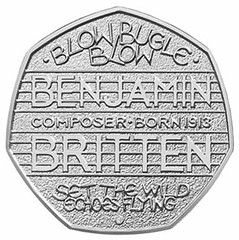 Great Britain is minting a new 50 pence coin to commemorate the centenary of the birth of composer Benjamin Britten.
Great Britain is minting a new 50 pence coin to commemorate the centenary of the birth of composer Benjamin Britten.
Engraved on the coin are poet Alfred Lord Tennyson's lines "Blow, bugle, blow, set the wild echoes flying," which Britten put to music in the Serenade for Tenor, Horn and Strings.
The design, by coin sculptor Tom Phillip, also shows Britten's name, framed by a double stave in recognition of his virtuosic piano skills. It is said to be the first time a person other than the Queen will have their full name featured on a 50p coin.
The Royal Mint said the coin will be available to collectors on September 27 and will go into general circulation on November 22.
To read the complete article, see: Britain Mints New Coin for Benjamin Britten Centennial (www.wqxr.org/#!/blogs/wqxr-blog/2013/sep/03/britain-mints-new-coin-benjamin-britten-centennial/)
THE BOOK BAZARRE
COIN FIND OF THE CENTURY DONATED TO ROMANIAN MUSEUM
Iulian Enache, 34, found the hidden treasure in the wilderness near the city of Ramnicu Valcea with the help of a metal detector he had recently bought.
The 54-kilo treasury, which was buried 30 centimeters in the ground, is worth some EUR 0.5 million at current market prices.
However Enache, who is passionate about archaeology, donated his discovery to the History Museum in Bucharest, without asking for anything in return.
The museum’s experts have confirmed the coins were issued in the 15th century by the Ottoman Empire.
Director of the History Museum Ernest Oberländer-Târnoveanu said the discovery was the largest silver treasury ever found in Romania.
“It is the biggest treasury recovered by a public institution in Romania, not only in the last 20 years, but in the last 100 years,” he said.
To read the complete article, see: Young Romanian gives museum largest silver coin treasure ever found in the country (www.romania-insider.com/young-romanian-gives-museum-largest-silver-coin-treasure-ever-found-in-the-country/105935/)
LOTS FROM THE KOLBE-FANNING SALE #130: CONDER, VAN LOON
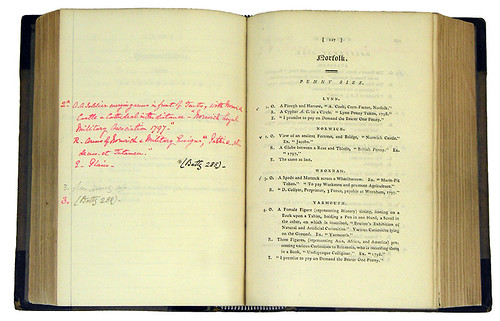
Lot 62: Conder's Arrangement
Conder, James. AN ARRANGEMENT OF PROVINCIAL COINS, TOKENS, AND MEDALETS, ISSUED IN GREAT BRITAIN, IRELAND AND THE COLONIES, WITHIN THE LAST TWENTY YEARS; FROM THE FARTHING TO THE PENNY SIZE. Ipswich, 1798. First edition. 12mo, somewhat later black half morocco, front cover lettered in gilt; spine with five raised bands, ruled and lettered in gilt. (24), 330, (2) pages; 3 engraved plates of tokens. Interleaved throughout, with annotations and cross-references on many pages. Title browned, as usual; binding a bit rubbed. Near fine. (500.00)
Ex Thomas Egerton Tatton, with his signature and bookplate, and annotated in his hand. A landmark work. Conder’s Arrangement was the first substantial text book on eighteenth-century English tokens and was dutifully honored by having the series named after the author. It remained the standard catalogue on conder tokens until it was replaced by Atkins a century later. Tatton’s notable collection of tokens and coins was sold by Sotheby’s, 6–7 November 1911. Ex David Litrenta library.
Lot 186: the French van Loon
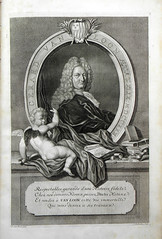 Loon, Gerard van. HISTOIRE MÉTALLIQUE DES XVII PROVINCES DES PAYS-BAS, DEPUIS L’ABDICATION DE CHARLES-QUINT, JUSQU’À LA PAIX DE BADE EN MDCCXVI. La Haye: P. Gosse, J. Neulme. P. De Hondt, 1732–37. Five volumes. Folio [39.5 by 26.5 cm], matching contemporary brown quarter morocco, gilt, with mottled boards. (30), 559, (1); (2), 541, (1); (2) 454; (2), 467, (1); (2), 444 pages; finely engraved title by Jan Goeree in the first volume; magnificent engraved portrait plate depicting van Loon by F. van Mieris; printed titles in red and black throughout with finely engraved vignettes; finely engraved dedication vignette; finely engraved headpieces, tailpieces and initials; profusely illustrated with fine engravings of medals throughout the text. Binding only a bit rubbed; third and fourth volumes with light discoloration to bindings; fifth with bruise to corner at spine tail affecting pages; overall, a very good set. (3000.00)
Loon, Gerard van. HISTOIRE MÉTALLIQUE DES XVII PROVINCES DES PAYS-BAS, DEPUIS L’ABDICATION DE CHARLES-QUINT, JUSQU’À LA PAIX DE BADE EN MDCCXVI. La Haye: P. Gosse, J. Neulme. P. De Hondt, 1732–37. Five volumes. Folio [39.5 by 26.5 cm], matching contemporary brown quarter morocco, gilt, with mottled boards. (30), 559, (1); (2), 541, (1); (2) 454; (2), 467, (1); (2), 444 pages; finely engraved title by Jan Goeree in the first volume; magnificent engraved portrait plate depicting van Loon by F. van Mieris; printed titles in red and black throughout with finely engraved vignettes; finely engraved dedication vignette; finely engraved headpieces, tailpieces and initials; profusely illustrated with fine engravings of medals throughout the text. Binding only a bit rubbed; third and fourth volumes with light discoloration to bindings; fifth with bruise to corner at spine tail affecting pages; overall, a very good set. (3000.00)
The preferred French edition of this magnificent classic work, first published a few years earlier in Dutch. Indispensable and still the standard reference on historical medals issued from 1556 to 1716. It remains a key source of information on European medals issued during this period relating to America. Clain-Stefanelli 14855*. Cumont 2086. Engel et Serrure 4341. Grierson 265. Lipsius 235.
For more information about the sale, see: www.numislit.com
FOURTH EXAMPLE OF ANTONY AND CLEOPATRA "LOVERS' COIN" FOUND
 It looked like any other 2,000-year-old coin on the day they dug it up.
It looked like any other 2,000-year-old coin on the day they dug it up.
Covered in two millennia's worth of rock and soil. Shrouded in mystery from a time so long ago that the Romans hadn't yet fully built their empire.
In other words, really, really dirty. So dirty that the person — most likely a college student — digging last summer at the Israeli site of a longtime University of Nebraska at Omaha archaeological dig couldn't see the famous faces on the coin. So dirty that the digger never realized she was, in fact, holding a tiny, priceless nugget of ancient civilization in the palm of her hand.
“We weren't amazed at all until we cleaned the coin and looked at it,” says Rami Arav, the University of Nebraska at Omaha professor who has led the Bethsaida Excavations Project in Israel for the past 27 years. “I looked at the face and then I knew — I was looking at a face from the history books.”
The face staring back at him: Cleopatra, the last pharaoh of ancient Egypt, the mother of two Roman leaders' children and one of the most powerful women in the history of the world.
He flipped it over, and there was Marc Antony, the Roman politician who happened to be one of Rome's two most important rulers at the time the coin was minted.
The Lovers' Coin, as its known, turns out to be as rare as Cleopatra herself.
Three were known to exist in the world, according to Dr. Greg Jenks, an Australian theologian and archaeologist who has worked at Bethsaida.
Experts say the coin was minted in Ptolemais, an ancient town 50 miles from Bethsaida, and put into circulation around 35 B.C., the year Marc Antony decided to move himself and a power center of the Roman Empire to Egypt.
To read the complete article, see: Hansen: UNO archaeological dig in Israel unearths priceless Cleopatra coin (www.omaha.com/article/20130906/NEWS/130909161/1685)
THE BOOK BAZARRE
WERTPAPIERWELT: THE MUSEUM OF HISTORICAL SHARES AND BONDS
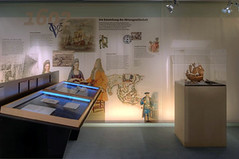 To commemorate its ten-year anniversary, the world’s most prominent collection of historical securities is presenting a new type of exhibition: one of modular design that invites visitors to look at the world of securities from different perspectives. In future, a two-part permanent exhibition will bear witness to the origin and spread of the joint stock company as well as explain how financial instruments function. This will be accompanied by a special exhibition that examines subjects of relevance to society, which this year takes the form of the globally networked nature of business.
To commemorate its ten-year anniversary, the world’s most prominent collection of historical securities is presenting a new type of exhibition: one of modular design that invites visitors to look at the world of securities from different perspectives. In future, a two-part permanent exhibition will bear witness to the origin and spread of the joint stock company as well as explain how financial instruments function. This will be accompanied by a special exhibition that examines subjects of relevance to society, which this year takes the form of the globally networked nature of business.
The anniversary exhibitions will feature 140 selected securities spanning the period from the very beginnings of the joint stock company to the present day, all displayed in an area of 300 sqm. Detailed explanations provide background information and outline the importance of each of the exhibits.
In summer 2003 Wertpapierwelt – the Museum of Historical Shares and Bonds – in Olten became the first international museum of its kind to make the world of shares and bonds, not to mention their influence on economic history, accessible to the public. Using historical securities – relicts from a bygone past – the museum illustrates how they interrelate and shows in a generally understandable manner how shares and other financial instruments have always influenced our economy.
While the first part of the permanent exhibition is mainly given over to helping us gain an understanding of the technical and legal aspects of securities, the second part provides us with a thrilling insight into the economic, technological and societal developments that we have witnessed since the invention of the joint stock company in 1602. The share has had a lasting impact on our present world as an instrument that has financed our society’s progress in the last 400 years and served as the basis for the spread of capitalism.
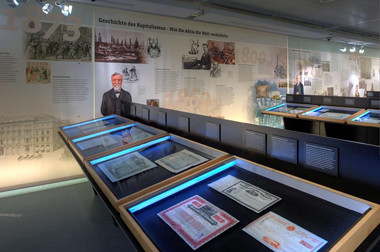
Thanks to its new modular exhibition design, Wertpapierwelt – Museum of Historical Shares and Bond – meets the expectations of all those visitors who want to just find out more about securities, their history and stock exchange trading. By combining the permanent exhibition with a current issue, a connection is established to our own experience that demonstrates how old shares and bonds are in no way dusty relics of history but have a message for developments in our current times.
Anyone who would like to find out more after viewing the variety of the securities on display can satisfy their hunger by taking a seat at a fictitious trading workplace set up on two PCs with access to the collection’s database.
The database contains both the fronts and backs of all the approximate 10,000 securities in the collection, and represents a unique archive of historical securities. A catalogue is available for the permanent exhibition with illustrations and explanations of all the securities on display, while a separate illustrated accompanying brochure takes you through the special exhibition. English-and French-speaking guides are at your disposal in the museum. The museum’s picture database encourages you to browse through the collection of the collection’s 10,000 historical shares and bonds.
To read the complete article, see: Ten years of Wertpapierwelt - Museum of Historical Shares and Bonds (www.coinsweekly.com/en/News/4?&id=2253)
COOK ISLANDS COIN CONTAINS PIECE OF CHELYABINSK METEORITE
On the morning of February 15, 2013, a meteorite hit the earth in the Ural Mountains. This time though, instead of landing a good distance away from populated areas, the enormous celestial body caused considerable damage to the people around the city of Chelyabinsk. Now, a unique coin issued by the Cook Islands allows the viewer to relive this dramatic event.

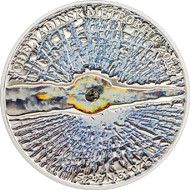
Depicted on the front of the coin is a portrait of the Cook Islands’ official head of state, Queen Elizabeth II. Her name, Elizabeth II appears along the rim, as does the name of the issuing country, Cook Islands, and the nominal value, 5 Dollars. The reverse of the coin features a coloured image field: A small fragment of the meteorite has been incorporated in the middle, surrounded by a coloured streak of flame running from left to right. Running above and below, from the middle towards the edge, are blue, irregularly broken stripes that represent shattered glass. The words Chelyabinsk Meteorite 2013 appear along the upper edge, and below, the geographic coordinates of the impact point: 54° 49' N, 61° 07' E.
To read the complete article, see: Cook Islands collector coin on Chelyabinsk meteorite (www.coinsweekly.com/en/News/4?&id=2244)
To read the earlier E-Sylum article, see: SOME OLYMPIC GOLD MEDALS TO CONTAIN RUSSIAN METEORITE FRAGMENTS (www.coinbooks.org/esylum_v16n32a13.html)
BALDWIN'S 83RD SALE TO BE HELD SEPTEMBER 24, 2013
Baldwin’s Auction 83 will be held on the 24th of September, at the CIPFA Conference Centre, London, in conjunction with Coinex 2013, the UK’s premier numismatic exhibition. The 1383 lots comprise an array of high quality Ancient and World coins and medals from around the globe, and include a stunning selection of coins from Antiquity representing an important numismatic, cultural and artistic era.
A lovely selection of British coins forms the second section of the auction and includes the late Alan Miles Collection of Short Cross Pennies and their Cut Halves. This fabulously formed collection features a number of medieval short cross pennies of King John all of the Moneyer “Miles”; a name that appears at the Oxford and Winchester Mints in the first decade of the 13th Century. These 45 lots represent over forty years of careful accumulation and dedication by Alan Miles to create a collection with outstanding provenance and numismatic value, lot 4242, a Silver Short Cross Penny, class Vbii, Winchester mint, being a particularly fine example. The piece carries a pre-sale estimate of £120-150
Elsewhere in the sale we have a major collection of coins of Ottoman Egypt; this stunning selection comprises coins of excellent quality and rarity from a foremost power of Middle Eastern and world history. The sale closes with a collection of Islamic coins followed by world and commemorative medals including medals with political intrigue and an unusual Wedgewood Creamware Portrait Medallion, c.1790, Lot 5374, Louis-Marie, Vicomte de Noailles (1756-1804), French General and Politicians amongst other fine examples from across history and the globe. This beautiful piece carries an estimate of £800-1,200
This auction is sold as part of a three day Baldwin’s auction extravaganza alongside The David Fore Collection of Indian Coins (Part three) and The Arielle Collection of British Colonial Coins (Part One). The auctions will take place in London during Coinex 2013, on the 24 – 26 September, at the CIPFA Conference Centre, Robert Street. Catalogues are available online at www.baldwin.co.uk.
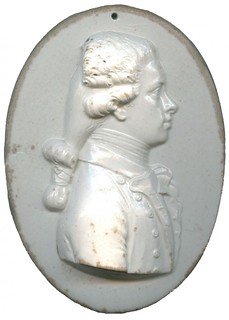 WORLD COMMEMORATIVE MEDALS. USA. Lou is-Marie, Vicomte de Noailles (1756-1804), French General and Politician, who served under Lafayette in North America and negotiated Cornwallis’s surrender after Yorktown in 1781, Wedgwood Creamware Portrait Medallion, c.1790, bewigged bust to right, tied in a queue, 87.5mm x 66.5mm, stamped WEDGWOOD on back (Reilly & Savage, 1973, p.260, “previously unrecorded”).
WORLD COMMEMORATIVE MEDALS. USA. Lou is-Marie, Vicomte de Noailles (1756-1804), French General and Politician, who served under Lafayette in North America and negotiated Cornwallis’s surrender after Yorktown in 1781, Wedgwood Creamware Portrait Medallion, c.1790, bewigged bust to right, tied in a queue, 87.5mm x 66.5mm, stamped WEDGWOOD on back (Reilly & Savage, 1973, p.260, “previously unrecorded”).
Made with a small piercing to the top (a slight chip where it penetrates the back), much as made and exceptionally rare .
De Noailles, the second son of Marshal de Mouchy, had served in America with Lafayette, his cousin and brother-in-law. He fought with d’Estaing at Savannah, and was present throughout the Yorktown campaign in Virginia where he was entrusted by Washington to be one of those who negotiated the terms of the final surrender. Following his service in the American Revolution he returned to France and was elected in 1789 to the States-General. He presided over the Constituent Assembly in 1791 and proposed the abolition of titles and liveries of the nobility.
Noailles fled to America (by way of England) when the reign of terror started, where he became a wealthy partner in Bingham’s Bank in Philadelphia. He left the bank to accept a command against the English in San Domingo. He was sailing for Havana in Cuba when he encountered a British man-of-war. Although he won the action, he was shot in the chest and died shortly after reaching Havana. The cataloguers are unaware of any metal medallic portraits of de Noailles, nor have they been able to trace any other examples in Creamware in public collections.
The portrait is taken from an engraving by Jean-Baptiste Verité. His painting by Gilbert Stuart hangs in the Metropolitan Museum in New York, whilst the action in which he was killed was painted by Jean Gudin. £800-1200
For more information, or to bid, see: WORLD COMMEMORATIVE MEDALS. USA. Lou is-Marie, Vicomte de Noailles (www.sixbid.com/browse.html?auction=914&category=18802&lot=870894)
FEATURED WEB PAGE: NOVA EBORAC COPPERS
This week's Featured Web Page is an introduction to the Nova Eborac Coppers from the University of Notre Dame Colonial Coins site.In March of 1787 the New York State Assembly took a stance restricting the circulation of lightweight coppers and rejecting all the petitions they had requested for permission to mint coppers. The two majors contenders for the minting rights took matters into their own hands. Thomas Machin and his partnership concluded an agreement with the Vermont mint and also began producing imitation British halfpence. The other major contender for the New York contract was the partnership of Ephraim Brasher and John Bailey. Brasher and Bailey also took matters into their own hands by privately minting Nova Eborac coppers (Nova Eborac being the Latin for New York).
The coins were made to look like contemporary British and Connecticut coppers with an obverse portrait of a mailed bust facing right and wearing a laureal wreath with the legend "NOVA EBORAC." The reverse contained a seated figure of Liberty holding a branch in one hand and a liberty pole in the other with a shield below, similar to Britannia, with the legend "VIRT. ET LIB." (Virtue and Liberty) and the date 1787 in exergue. These coins were accepted and regularly used for they are usually found in well circulated condition. Their weight range is from 88 - 150 grains.
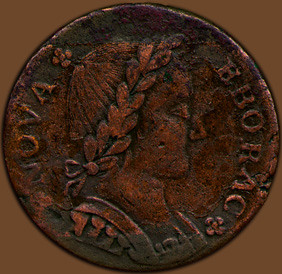
www.coins.nd.edu/ColCoin/ColCoinIntros/
NovaEbor.intro.html

